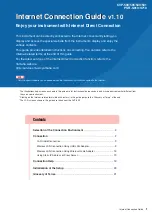
Basic Structure
MOTIF XS Owner’s Manual
76
Basic Structure
Basic Operation
Connections
Basic Section
About MIDI
MIDI (Musical Instrument Digital Interface) is a standard which allows electronic musical instruments to communicate with
each other, by sending and receiving compatible Note, Control Change, Program Change and various other types of MIDI
data, or messages.
This synthesizer can control other MIDI devices by transmitting note related data and various types of controller data. It can
also be controlled by incoming MIDI messages which automatically determine the tone generator mode, select MIDI
channels, voices and effects, change parameter values, and of course play the voices specified for the various Parts.
MIDI channels
MIDI performance data is assigned to one of sixteen MIDI
channels. Using these channels, 1 – 16, the performance data
for sixteen different instrument parts can be simultaneously
sent over one MIDI cable.
Think of the MIDI channels as TV channels. Each TV station
transmits its broadcasts over a specific channel.
Your home TV set receives many different programs
simultaneously from several TV stations and you select the
appropriate channel to watch the desired program.
MIDI operates on the same basic principle.
The transmitting instrument sends MIDI data on a specific
MIDI channel (MIDI Transmit Channel) via a single MIDI cable
to the receiving instrument. If the receiving instrument’s MIDI
channel (MIDI Receive Channel) matches the Transmit
Channel, the receiving instrument will sound according to the
data sent by the transmitting instrument.
For information on how to set the MIDI transmit channel and
the MIDI receive channel, see page 267.
MIDI messages transmitted/
recognized by this synthesizer
The messages transmitted/received by the MOTIF XS are
shown in the MIDI Data Format and MIDI Implementation
Chart in the separate Data List booklet. The MOTIF XS tone
generator block (indicated “synth. part” in the Data List) and
sequencer block (indicated “seq. part” in the Data List) handle
different MIDI messages. The MIDI messages which the
sequencer block can receive can be recorded to tracks of a
Song/Pattern. On the other hand, the MIDI messages which
the tone generator can receive can affect the MOTIF XS
sound.
This section covers MIDI events, the data format by which the
MIDI messages generated by your keyboard performance are
recorded to a track of a Song/Pattern. Theses events
described below can be edited or inserted in the displays of
the Song Edit/Pattern Edit modes.
Note
These are the events that define notes, making up the largest
portion of all performance data. The note name (C -2 – G8)
defines the pitch. The gate time specifies the length of the
note in beats and clocks. Velocity (1 – 127) is “how hard” the
note is played. The bar graph to the right is a graphic
representation of the value.
Pitch Bend
Pitch bend events are generated by pitch bend wheel
operation and define continuous changes in pitch. The value
(-8192 – +0000 – +8191) is a numerical representation of pitch
bend wheel position. The bar graph to the right is a graphic
representation of the value.
Program Change (PC)
Program change events select Voices. The Bank Select MSB
and LSB parameters are actually included in the Control
Change category, below, but since in the MOTIF XS these
1
2
2
Weather Report
News
News
MIDI Receive channel 2
MIDI Transmit channel 2
MIDI
cable
MIDI events handled by the MOTIF XS
Note name
Gate time
Velocity
Bar graph
of velocity
Data value
Bar graph of
the data value
Bank Select MSB
Bank Select LSB
Program number
Voice name
Summary of Contents for MOTIF XS6
Page 1: ......
















































